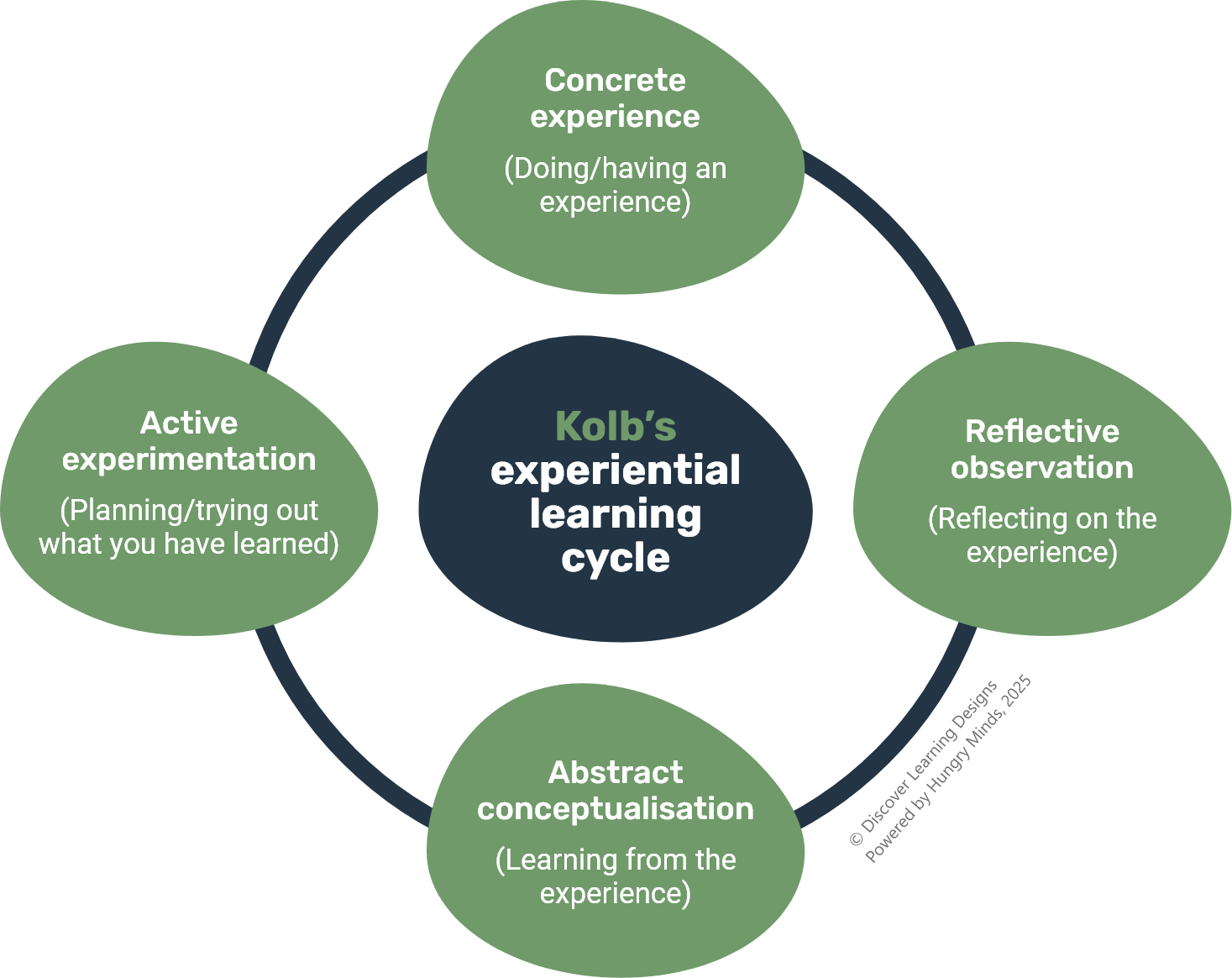Show, Don’t Tell: Experiential Learning in Digital Spaces
An engaging experience can turn yawning learners into active participants in a snap. Spicing things up with the help of experiential learning principles can keep your sessions focused and your learners on the edge of their seats every time. Let’s discover how you can apply these strategies in your own lessons.
What is Experiential Learning?
Remember that time you learned to ride a bike? Bet you didn’t start by reading a manual. Educational guru David Kolb figured out what we all kind of knew: we learn best by diving in and giving things a whirl. In the digital world, this means swapping endless PowerPoint slides for virtual labs, simulations and interactive scenarios that get learners applying their insights.
Kolb’s experiential learning cycle outlines four stages:
- Concrete Experience: Learners jump in and do the task.
- Reflective Observation: They think about what just happened.
- Abstract Conceptualisation: Learners make sense of their experience, connecting the dots and forming conclusions.
- Active Experimentation: They try it again, but better this time, applying what they’ve learned to a new situation.

Why Should We Care About Experiential Learning?
- Your Brain Loves Action: Turns out, we remember 75% of what we do, but only 10% of what we read. Sorry, textbooks – it’s not you, it’s us. When learners are in the driver’s seat, magic happens.
- Skills That Stick: Theory is great at parties, but practice pays the bills. Experiential learning builds skills that translate directly to the real world. No more “but how does this apply to my job?” moments.
- Enhanced Problem-Solving: When learners tackle realistic challenges, they develop a mental toolkit that works in any situation.
Making Experiential Learning Work in the Real World
- Simulations That Don’t Feel Fake
Create scenarios that feel real enough to make palms sweat (in a good way). Like customer service training where the “virtual Karen” is just as challenging as the real thing. - Games That Teach
Not all heroes wear capes – some earn badges for mastering health and safety protocols. Turn mundane tasks into engaging challenges. - Encourage Reflection
Build in moments for learners to process what just happened. Integrate prompts for reflection or peer discussions to deepen understanding. - Enable Real-Time Feedback (That Doesn’t Feel Like Criticism)
Instant feedback is like having a supportive friend who’s not afraid to tell you when you’ve got spinach in your teeth. Helpful, immediate, and kind of essential.
Real-World Example: Virtual Escape Rooms
Picture this: Your team is trapped in a virtual room, armed only with their wits and a Zoom connection. Corporate training has gone full Mission Impossible, minus Tom Cruise’s running scenes. Teams solve puzzles, communicate under pressure, and learn to work together – all without leaving their desks. It’s like team building meets puzzle solving meets “why is Bob still muted?”.
Tips for Successful Experiential Learning Design
- Know Your End Game: Before you begin building, figure out what you actually want people to learn. Crazy, right?
- Keep It Real: If your scenarios feel more fictional than a superhero movie, it’s time to dial it back. Unless you’re actually training superheroes. In that case, carry on.
- Make It User-Friendly: Ensure tools and platforms are user-friendly and inclusive. (If your learning platform needs its own training course, get a new one!)
- Balance Challenge and Support: Design activities that are engaging yet achievable, providing guidance where necessary.
- Listen and Learn: Collect feedback like it’s going out of style. Then actually use it. Revolutionary, we know.
How Graphic Design Can Boost Your Career
Whether you’re looking to enter the creative industry or enhance your current role, graphic design skills open up many opportunities:
- Creative Careers: Graphic design is essential in branding, advertising, web design, and multimedia production.
- Education & Training: Teachers and instructional designers can enhance learning materials with compelling visuals.
- Freelancing & Entrepreneurship: Offer design services for clients, creating logos, social media content, and marketing materials.
The Bottom Line
Stop telling people things and start showing them instead. Your learners will thank you, probably with fewer yawns and more “aha!” moments.
Remember: in the battle between telling and showing, showing wins every time.
References
- Dale, E. (1969). Audio-Visual Methods in Teaching. Holt, Rinehart, and Winston. https://archive.org/details/audiovisualmetho0000dale
- Kolb, D. A. (1984). Experiential Learning: Experience as the Source of Learning and Development. Prentice Hall. https://www.researchgate.net/publication/235701029_Experiential_Learning_Experience_as_the_Source_of_Learning_and_Development
